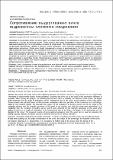| dc.contributor.author | Найчук, Анатолий Яковлевич | |
| dc.contributor.author | Маркечко, Екатерина Владимировна | |
| dc.coverage.spatial | Москва | ru_RU |
| dc.date.accessioned | 2024-12-13T09:01:22Z | |
| dc.date.available | 2024-12-13T09:01:22Z | |
| dc.date.issued | 2023 | |
| dc.identifier.citation | Найчук, А. Я. Сопротивление выдергиванию винта из древесины элемента соединения / Н. Я. Найчук, Е. В. Маркечко. – Текст : непосредственный // Промышленное и гражданское строительство. – 2023. – № 8. – С. 35–41 : ил. – Библиография: 13 назв. | ru_RU |
| dc.identifier.uri | https://rep.bstu.by/handle/data/46515 | |
| dc.description | Naichuk Anatoly Yakovlevich, Markechko Ekaterina Vladimirovna. Resistance to pulling out of the screw from the wood of the connection element | ru_RU |
| dc.description.abstract | В настоящее время изучение работы соединений элементов деревянных конструкций с использованием
винтов – весьма актуальная задача. Представлена методика экспериментальных исследований сопротивления
выдергиванию винта из древесины элементов соединений. При испытании образцов в качестве варьируемых
факторов принимались: диаметр винтов, длина анкеровки и угол наклона продольной оси винта к направлению
волокон древесины. Схема испытаний принималась исходя из максимального соответствия работе соединения
в реальной конструкции. На основании результатов исследований определены характеристические значения
сопротивления выдергиванию винтов из древесины элемента соединения и параметра прочности древесины
в зоне контакта с винтом. Установлено, что сопротивление выдергиванию винтов из древесины зависит
от параметра прочности древесины при выдергивании винта под углом наклона его продольной оси к волокнам,
длины анкеровки и диаметра винта. Предложенные модели сопротивления выдергиванию винта из древесины
могут быть использованы при оценке несущей способности соединений элементов деревянных конструкций с
винтами различных диаметров. | ru_RU |
| dc.language.iso | ru | ru_RU |
| dc.publisher | Издательство ПГС | ru_RU |
| dc.subject | соединение элементов деревянных конструкций | ru_RU |
| dc.subject | connection of elements of wooden structures | ru_RU |
| dc.subject | сопротивление выдергиванию винта | ru_RU |
| dc.subject | resistance to pulling out of the screw | ru_RU |
| dc.subject | параметр прочности древесины при выдергивании | ru_RU |
| dc.subject | the strength parameter of wood when pulling out | ru_RU |
| dc.subject | угол наклона винта | ru_RU |
| dc.subject | the angle of inclination of the screw | ru_RU |
| dc.subject | длина анкеровки | ru_RU |
| dc.subject | the length of the anchorage | ru_RU |
| dc.subject | диаметр винта | ru_RU |
| dc.subject | the diameter of the screw | ru_RU |
| dc.title | Сопротивление выдергиванию винта из древесины элемента соединения | ru_RU |
| dc.type | Статья (Article) | ru_RU |
| dc.identifier.udc | 624.011.1:621.882.1 | ru_RU |
| dc.abstract.alternative | At present, the study of the work of joining elements of wooden structures using screws is a very urgent task.
The method of experimental studies of the resistance to pulling the screw out of the wood of the connection elements is
presented. When testing the samples, the following factors were taken as variable: the diameter of the screws, the length
of the anchorage and the angle of inclination of the longitudinal axis of the screw to the direction of the wood fibers.
The test scheme was adopted based on the maximum compliance with the operation of the connection in a real design.
Based on the research results, the characteristic values of the resistance to pulling screws out of the wood of the
connection element and the strength parameter of the wood in the contact zone with the screw were determined. It is
established that the resistance to pulling screws out of wood depends on the strength parameter of the wood when
pulling the screw at an angle of inclination of its longitudinal axis to the fibers, the length of the anchorage and the
diameter of the screw. The proposed models of screw pull-out resistance from the wood can be used in assessing the
bearing capacity of joints of wooden structure elements with screws of various diameters. | ru_RU |
| dc.identifier.doi | 10.33622/0869-7019.2023.08.35-41 | |
